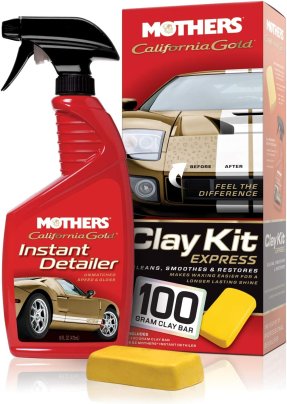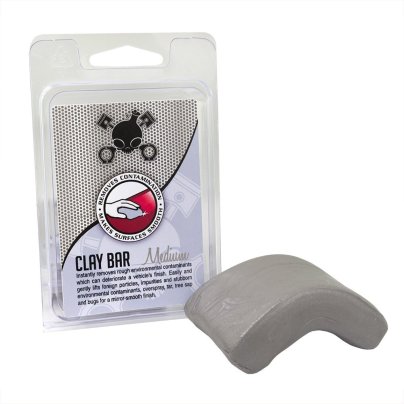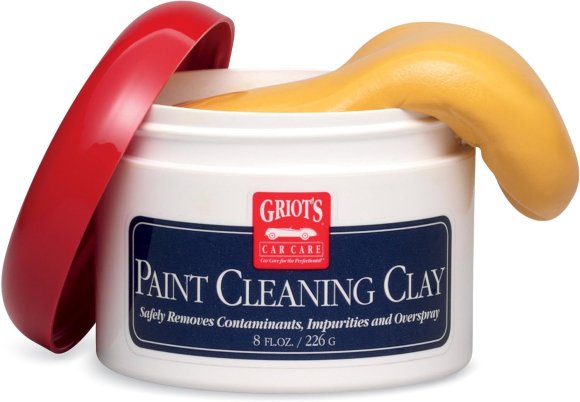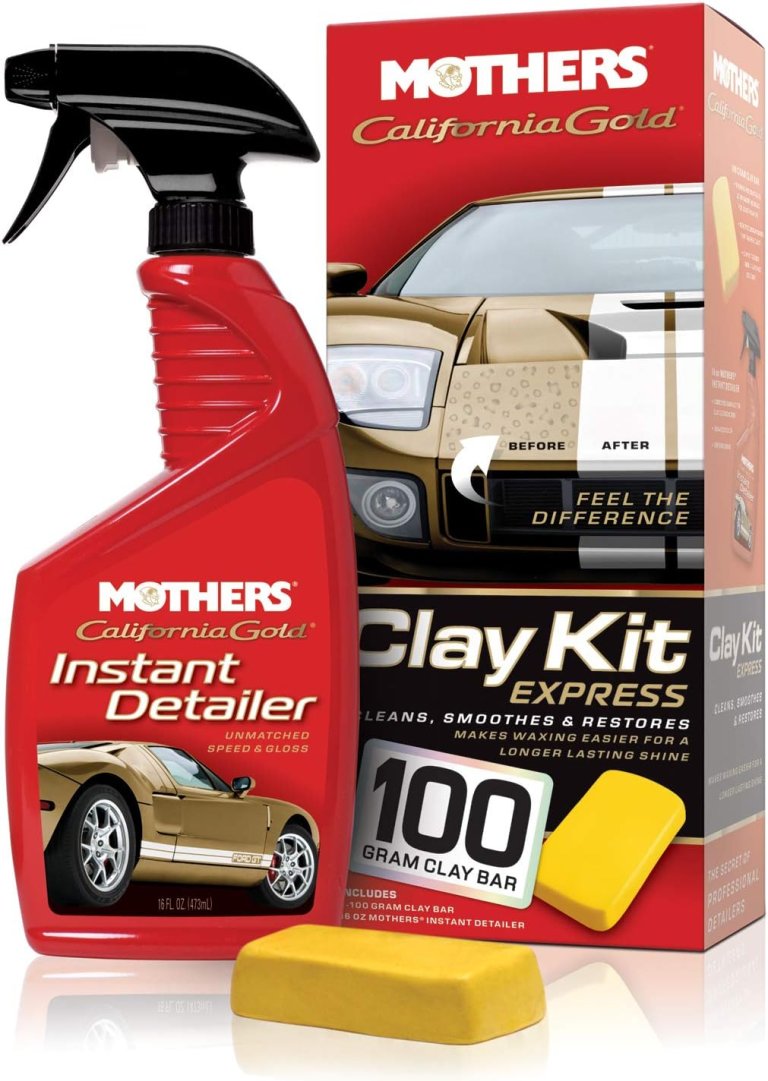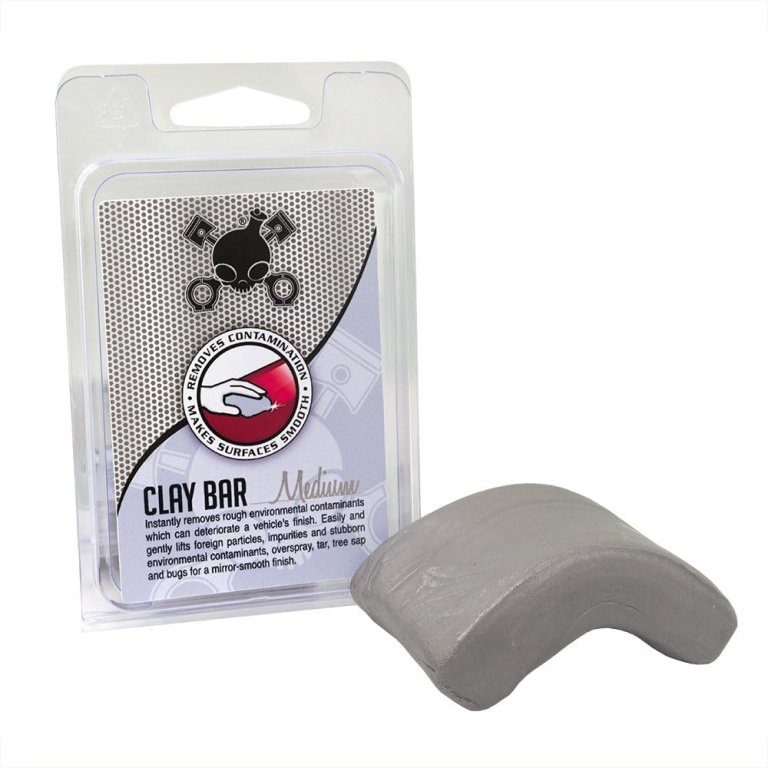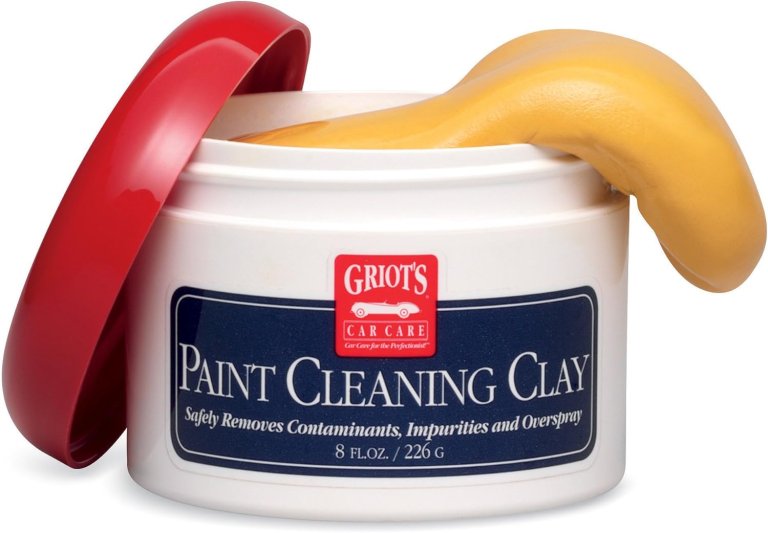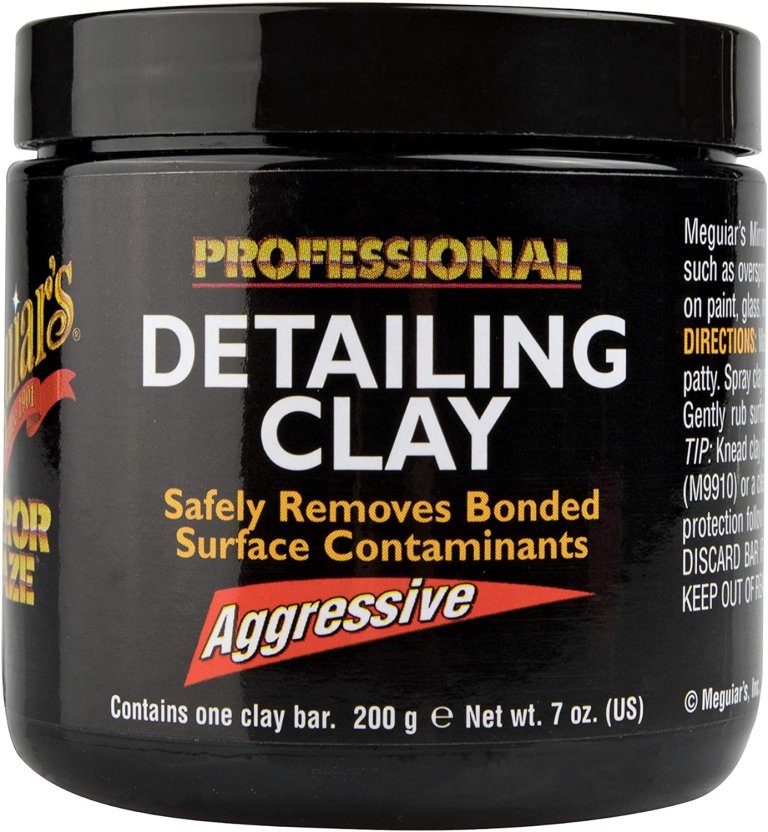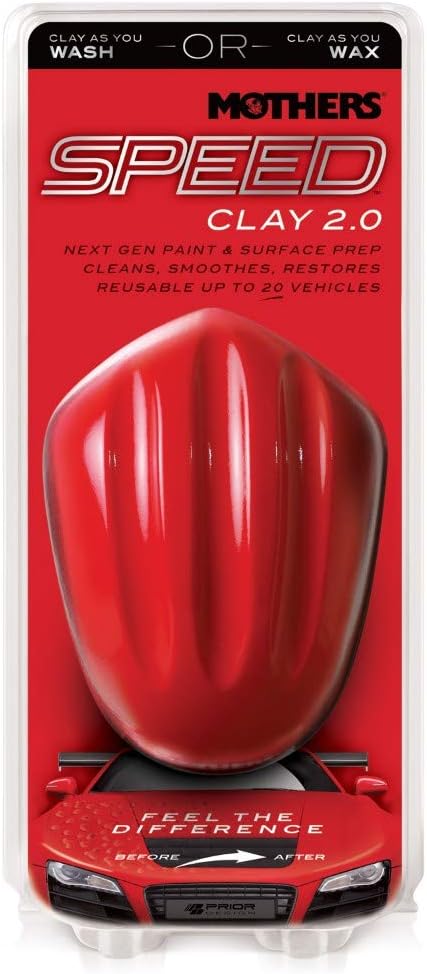We may earn revenue from the products available on this page and participate in affiliate programs. Learn more ›
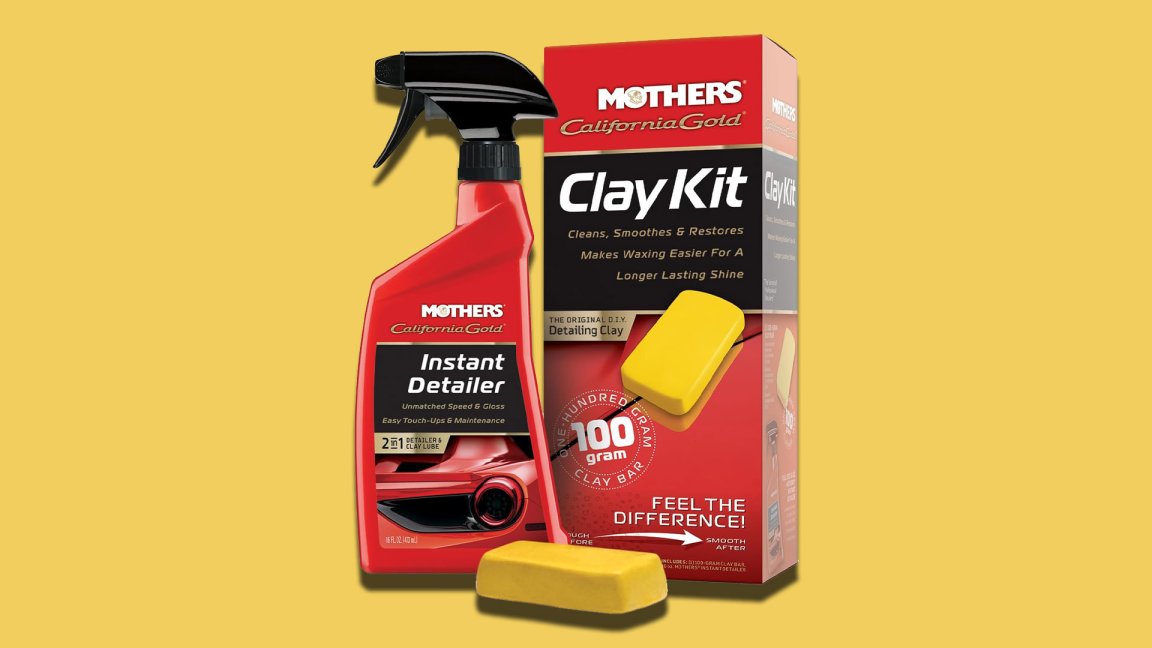
No matter how many times you’ve washed your ride, there’s always bits left behind. Those bits can be things like tiny particles of dirt, pieces of dead bugs, or bits of bird droppings that you can barely see but can feel when you run your hand down a fender. Soap and water will never get them off, and waxing just covers them.
To remove those annoying pieces of detritus, you need a clay bar. A clay bar on your paint is like a pumice stone on tired feet or a detoxifying face mask. It removes the bad stuff and leaves you with a surface that’s fresh and smooth. This is how you find the best clay bar for you and your paint. In this article, we’ll round up some of the best clay bars on the market to help you find the one that fits your exact needs.
Summary List
- Best Overall: Mothers California Gold Clay Kit Express
- Best Value: Chemical Guys Medium Clay Bar
- Premium Pick: Griot’s Garage Paint Cleaning Clay
- Best for Severe Jobs: Meguiar’s C2100 Detailing Clay
- Easiest to Use: Mothers Speed Clay 2.0
How We Selected the Products
To choose the best clay bars, we looked at brands that are known for providing the best detailing products. Your paint is the most noticeable part of your vehicle and probably the most expensive to fix, so tried and tested products are important. We avoided products from unknown companies for the same reasons. Price is important and so is usability, or how well the clay sticks together when you use it without sticking to the paint. A reusable container is also important because you’re not likely to use the whole product at once and you don’t want to just stick it in a grocery bag every time.
Our product selections, rankings, and awards for this story are based on research. While we haven’t conducted real-world testing on all of these products yet, we’ve looked at consumer testimonials and data, tutorials, and general discussions on social media and in forums. We also consider price and specification in the context of the segment. And, of course, we rely on our institutional knowledge of the automotive landscape to weed out weak products.
Best Clay Bars: Reviews & Recommendations
Best Overall: Mothers California Gold Clay Kit Express
Pros
- Clay bar and detailer
- DIY friendly
- Low price
Cons
- No bar storage
- Can’t choose coarse or fine clay
To use a clay bar on your car, you need a lubricant. This kit from Mothers comes with both in one package. You get a 100-gram bar and a 16-ounce bottle of Mothers California Gold Instant Detailer to help you get the job done. While other bars let you choose from fine or coarse clays, the latter being something better left to an expert, the Mothers bar is meant to be DIY friendly for beginners. The bar is more malleable than other bars, making it easier to mold to the vehicle and easier to use. So, it’s fine if you’ve never clay-barred a vehicle before.
One bar should be enough to completely clay a full-size car or most SUVs, which is good because Mothers doesn’t include a place for you to store the bar once you’re done. That means you’re probably going to throw out what’s left. If you’ve got Instant Detailer left, though, you can keep using that for a quick shine (with a cinnamon scent) on your vehicle.
Best Value: Chemical Guys Medium Clay Bar
–
Best Value
Chemical Guys Medium Clay Bar
Check Latest PricePros
- Medium density for your average use
- Comes in a reusable blister package
- Color coded if you have more than one grade
Cons
- Plastic wrap tough to remove
- Softer than other bars
- Color means dirt can be tougher to see
Premium Pick: Griot’s Garage Paint Cleaning Clay
–
Premium Pick
Griot’s Garage Paint Cleaning Clay
Check Latest PricePros
- Large bar
- Resealable tub
- Extra malleable
Cons
- Light density won’t remove worst dirt
- Softer and stickier than other brands
The Griot’s Garage Clay Bar is more than just a bar. It’s more than double the size of the other bars on this list. Coming in a large tub instead of a single bar, Griot’s lets you take just a small amount of clay out of the container each time. You never need to dirty more clay than you need, you don’t need to worry about throwing out a whole bar because you dropped it on the ground, and you can use a small amount to handle the extra-gritty parts of the job such as rocker panels and wheels. The storage tub keeps the rest secure and clean until the next use.
Griot’s says the tub can clean about seven vehicles, depending on the size of the vehicle and the amount of contamination. This is light clay, so it may not remove the most stubborn contamination. Our hands-on review also revealed the clay’s tendency to crumbly and stick to the vehicle.
Best for Severe Jobs: Meguiar’s C2100 Detailing Clay
Pros
- Aggressive clay for worst contamination
- 200-gram bar
- Comes with storage tub
Cons
- Stiffer to use
- Expect to have to machine polish after clay
- Takes lots of rubbing
Meguiar’s C2100 clay is labeled as aggressive, and that means it is ready to remove even the most stubborn contamination such as road tar, paint overspray, rail dust, and even industrial fallout. If it’s adhered to your paint surface, this will remove it. Plus it can do the same for glass, metal, and even plastic surfaces. While this product will remove virtually any contamination from your paint, there are some tradeoffs. This clay is going to take more elbow grease from you, the person rubbing the paint. A bar this aggressive will likely leave what’s called clay maTakes lots of rubbing rring, tiny scratches in the finish that will need machine polishing and waxing. That extra step is just part of the game when it comes to making your vehicle’s paint as smooth as possible.
This is a large bar and it comes with a reusable tub to store what you don’t use. However, even the 200-gram bar may not last for multiple vehicles because of how much dirt it can remove from your vehicle. For finishes that need it, though, this pro-level clay bar is tough to beat.
Easiest to Use: Mothers Speed Clay 2.0
Easiest To Use
Mothers Speed Clay 2.0
Check Latest PricePros
- Can clay up to 20 vehicles
- Easy-use applicator
- No dropped-bar worries
Cons
- Less aggressive than clay
- Applicator and bar can separate
- Mothers warns of counterfeits
Mothers has reimagined the clay bar with its Speed Clay 2.0. Instead of a malleable lump, Mothers has taken the clay bar and bonded it to an easy-to-use handle. It also behaves more like an eraser than traditional clay.u003c/pu003eu003cpu003eNo more folding the clay over and over again, Speed Clay lets you hold the ergonomic applicator and rub the paint with comfort. The rubber polymer technology shears off, removing paint contaminants as well as the contaminated particles of the clay
With Mothers Speed Clay, you can actually clay your car as you wash it, instead of adding a second step and using a spray detailer or lubricant. You can even clay the car as you are waxing it. Less work and more shine is the goal, and thanks to this new clay system, that’s exactly what you’ll get. Unlike conventional clay bars, this bar isn’t sticky. So, if you drop it on the ground, which would ruin a normal bar, you can hose off Speed Clay or dip it in your wash bucket, and it is safe to use again on your paint. Thanks to the new tech, one bar can be used to clean up to 20 vehicles.
Our Verdict
Mothers California Gold Clay Kit Express won our pick for best clay bar overall based on its price, the fact that it comes with almost everything a DIYer needs, and because the coarseness of the clay is a great balance of effectiveness and beginner friendliness. Now get out there and make your paint hood smooth.
What to Consider When Buying Clay Bars
Types of Clay Bars
There are big differences between the different types of clay bars. Natural and synthetic, different grades of coarseness, and even different uses. We’ve summarized some of the key things you should look for and the things you should know.
Compound Strength
There are three main types of clay bars: fine, medium, and aggressive. Fine clay bars are perfect for vehicles with less contamination or for users who want to clean their finish but not spend all day doing it. They’ll remove much of the contamination but not all. They’re easier to slide across your paint and less likely to leave scratches. Medium bars bridge the middle ground, removing more stubborn contamination while still being OK for the average user. Aggressive clays will remove the most stubborn paint contamination. However, they’ll take more elbow grease to do it, and you’ll almost certainly need to machine polish your paint after you finish with the clay.
Glass Cleaning
A clay bar is a great way to clean your car’s windshield, too. A mild bar can remove stubborn debris that makes your windshield rough, hurts your visibility when the sun is low, and causes your wipers to leave water behind. It won’t get rid of pitting, but it can make a big difference. While most bars are glass-safe, check to make sure on the bar you’re planning to use.
Rubber Polymer/Synthetic
Rubber and synthetic clays like Mothers Speed Clay 2.0 are more like a sponge with a handle. They have two very different layers, one for the paint and one to hold on to. They’re not actually clay, but the handheld layer and the properties of the rubber “clay” layer make them much easier to use. Easier to hold, they also don’t require that you fold in contaminants and re-shape the bar with each panel of your vehicle.
Key Features
Size
How much clay you’ll need depends on the size of your vehicle, how dirty it is, and how aggressively you’re planning to rub. Most clay comes in a 100-gram bar. With a mild clay, that should cover a couple vehicles. With a more aggressive clay or a more contaminated vehicle, you’ll probably need more. In that case, a 200-gram bar or a product that gives you multiple 100-gram bars in one container is probably a better bet. If you only need 100 grams, don’t buy a larger size. The clay can dry out over time.
Lubricant
Clay bars must be used with a lubricant, either one designed specifically for the purpose or a spray detailer or spray-wax product. If you don’t use one, the clay can stick to the paint and damage it. The most important thing here is that it makes the surface slick for the bar to slide across, so if you already have a favorite product on the shelf it should be fine to use.
Clay Bar Pricing
Clay bars live in the $10-$20 price range. Size, type, quality, and quantity can all directly impact the cost. Some premium models list for more than $20, with many coming with some form of complementary lubricant.
FAQs
You have questions. The Drive has answers!
The easiest way to try out clay barring is to pick a trim piece closer to the ground that is less visible or to use or to try it out on a painted piece you don’t care about. A visit to the local junkyard may give you a low-cost panel to work on. Spray both the painted piece and clay bar liberally with lubricant. Begin with light pressure and measured movements.
Pick a spot on the paint that you want to remove, making sure it is a contaminant and not a scratch or paint chip. After spraying the clay bar and a small area around this spot, move the clay bar across the clean surface of the spot, making a few passes. Lift the clay bar, fold it over, and make another pass. If it glides more smoothly than the first pass, it is removing contaminants.
Fresh clay bars, straight from the package, should not scratch your paint. However, if you end up picking up sharp debris, it can scratch your paint. Watch the path of your clay bar as you move across the paint. Pause every so often to inspect the clay bar itself and knead it, folding in to get a fresh surface. Dig out any contaminants you can see and discard. If you drop the bar on the ground, it’s time to toss it.
The short answer is probably not. Depending on the application and age of the touch-up paint, the clay bar could end up removing it, leaving you with the original paint chip. If you happen to move across the touch-up paint as you go, you likely won’t cause any damage, but note these spots as you go in order to avoid them.
